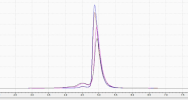Some testing on storage conditions and dimer relationship was conducted. 2 separate vials tested each test.
This was done as a low effort testing out of personal interest while investigating something else, not a study intended for a publication.
Sample X HGH, possibly pharmaceutical grade, but I'm unable to verify:
Arrival to the lab - 2nd of June 2023: 2.298%, 2.261%
Stored at room temp - 21nd of July 2023: 4.075%, 2.991%
Stored 25 days at room temp and remaining time in the fridge at 4°C - 21nd of July 2023: 2.785%, 3.08%
Stored at an oven with max temp 50°C and average temp 40°C - 21nd of July 2023: 3.765%, 3.672%
Stored taped to outside of the window with label taken off, on the sunny side of the building - 21nd of July 2023: 10.657%, 15.513%
Now some graphs, because everyone loves the graphs:
Upon arrival + window:

Zoomed in:
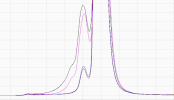
Upon arrival + window + stored at room temp zoomed in:
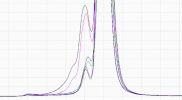
Upon arrival + window + stored at room temp + stored half the time in the fridge zoomed in:
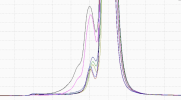
Upon arrival + window + stored at room temp + stored half the time in the fridge + oven zoomed in:
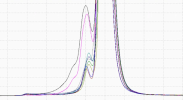
Upon arrival + window + stored at room temp + stored half the time in the fridge + oven + completely different low dimer generic sample zoomed in:
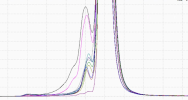
This was done as a low effort testing out of personal interest while investigating something else, not a study intended for a publication.
Sample X HGH, possibly pharmaceutical grade, but I'm unable to verify:
Arrival to the lab - 2nd of June 2023: 2.298%, 2.261%
Stored at room temp - 21nd of July 2023: 4.075%, 2.991%
Stored 25 days at room temp and remaining time in the fridge at 4°C - 21nd of July 2023: 2.785%, 3.08%
Stored at an oven with max temp 50°C and average temp 40°C - 21nd of July 2023: 3.765%, 3.672%
Stored taped to outside of the window with label taken off, on the sunny side of the building - 21nd of July 2023: 10.657%, 15.513%
Now some graphs, because everyone loves the graphs:
Upon arrival + window:
Zoomed in:

Upon arrival + window + stored at room temp zoomed in:

Upon arrival + window + stored at room temp + stored half the time in the fridge zoomed in:

Upon arrival + window + stored at room temp + stored half the time in the fridge + oven zoomed in:

Upon arrival + window + stored at room temp + stored half the time in the fridge + oven + completely different low dimer generic sample zoomed in:

Attachments
Last edited:


